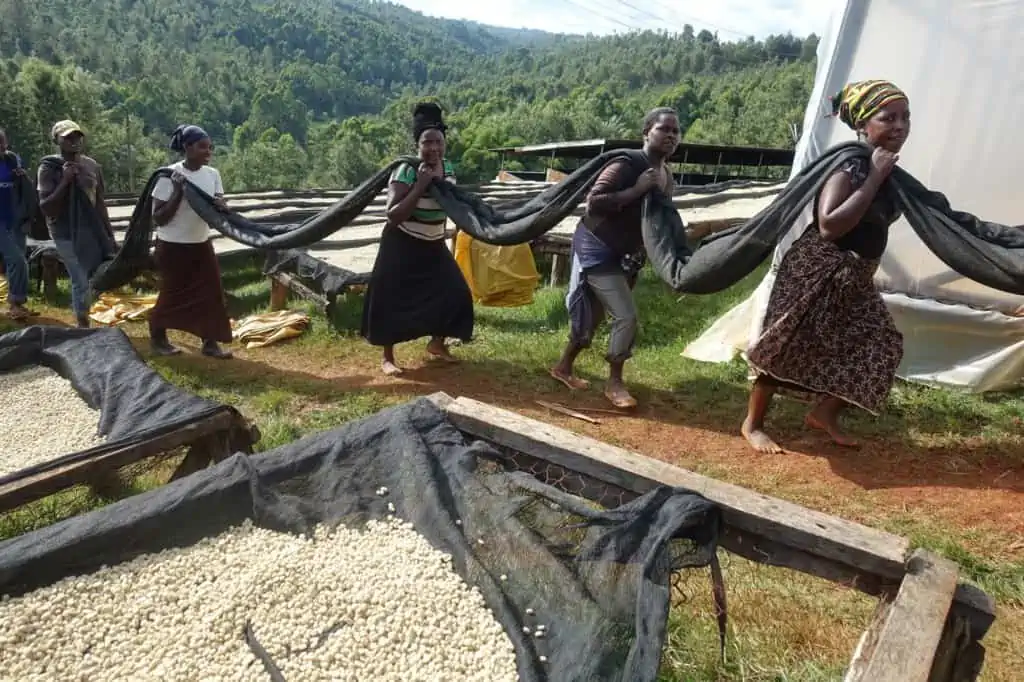
Transporting processed coffee to storage in the Kiambu growing region of Kenya. Photo courtesy of Caesar Tu.
What makes a coffee taste like it does? Many factors go into what you ultimately experience in your morning cup.
First, there’s the tree variety that produces the coffee. For specialty coffees, the varieties in question are, with rare exceptions, of the Arabica species, and there are hundreds of possibilities. Then, there’s the place in which the tree is grown — the coffee’s terroir. (There is no direct translation into English of this French word, which refers to the holistic environment in which a plant is grown, including the specific soil type, weather, altitude, and other factors.) Once the ripe coffee cherries are picked, processing is the next big x-factor. While processing experiments are all the rage in specialty coffee right now, we’ll be focusing on the classic washed method here. There are enough variations on this one method to start a conversation about the influence of processing decisions on a coffee’s final product. With the exception of the crucial final step of brewing, the last major influence on a coffee’s journey to your cup is roasting, and each of the coffees featured in this month’s report have been expertly roasted, albeit subject to different roast profiles.
For this month’s report, we re-visited the coffees of Kenya, cupping 65 samples from roasters across the U.S, Canada and Taiwan. The top-scoring 11 reviewed here rated 94-95, a very impressive showing, and 19 more scored 90 or higher, meaning that roughly half of the coffees submitted scored 90 or above. In part, this success reflects the excellence and consistency for which Kenya coffees are known. It also may speak to an unusually high-quality crop out of Kenya this year, or overall skillful lot selection by importers and roasters.
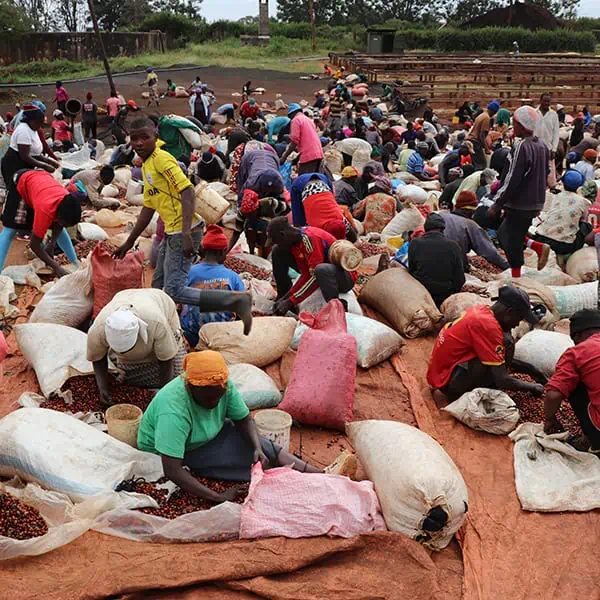
Sorting fresh cherry at the Kibirigwi Co-op in Kenya’s Kirinyaga District. Photo courtesy of Klatch Coffee.
So, again, let’s consider the question — what makes a coffee taste like it does — specifically through the lens of coffees from Kenya, in particular the 11 we review this month. Kenya, as a coffee-producing origin, is a good case-in-point for an exploration of the multitude of factors that influence cup profile because, as many experienced coffee drinkers know, good Kenya coffees often display recognizable, consistent distinctions from coffees of other origins. A Kenya is frequently recognizable on a blind table, sometimes even by aroma alone.
Kenya Tree Varieties
One factor that helps distinguish Kenya coffees from those of other origins is the classic varieties of Arabica that have long dominated production: SL28 and SL34. SL stands for Scott Agricultural Laboratories, established by the British colonial government in Kenya in 1922. Both SL28 and SL34 were selections made by the Scott Labs between 1935 and 1939, primarily and initially on the basis of drought-resistance. Recent genetic research shows SL28 as Bourbon-related and SL34 as Typica-related.
SL28 is the variety that is most often associated with the classic aromas and flavors of Kenya coffees. Think dark berries — the most common dead ringer is black currant notes, but SL28 can also evoke blackberry, raspberry and other jammy berries — and sometimes umami-laden ripe tomatoes, which can add a complex savory tone. SL28 also tends to have strikingly bright, juicy acidity that contributes complexity and balance to the cup when juxtaposed with deep fruit-sweetness.
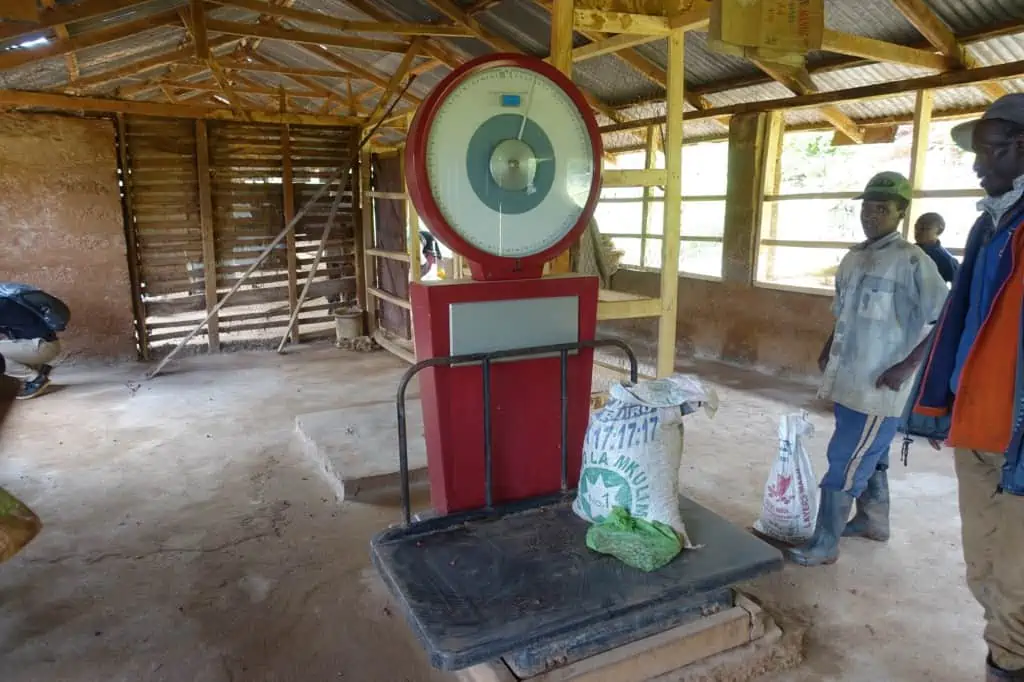
Weighing just-picked coffee cherry. Photo courtesy of Kakalove Cafe.
SL34, while not as dynamic as SL28, typically offers citrusy acidity and a full body. It usually shows up mixed with SL28 in Kenya-grown coffees.
The Kenya Hybrid Controversy
One plot twist in the Kenya coffee narrative is the increased plantings of disease-resistant hybrid varieties that may alter the distinctive Kenya cup. Two coffee fungus diseases, leaf rust and coffee berry disease (CBD), have been particularly destructive in Kenya over recent decades – Kenya lost 50% of its coffee crop to CBD in 1968. Ruiru 11, introduced by Kenya coffee authorities in the 1980s, resists both diseases, particular CBD, and is high-yielding and compact-growing. It is a complex cross of several varieties, among them SL28 and SL34 for cup quality and Hibrido di Timor (HdT), itself a natural cross between Arabica and Robusta, for disease resistance. However, its cup character has proven to be controversial. Many cuppers claim that the Robusta influence appears in the cup, flattening the contributions of the SL 28 and SL34.
In 2010, Batian arrived on the scene. It is a single-tree selection from the fifth generation of Ruiru 11 stock, chosen for its large tree size (similar to SL28 and SL34) and superior cup quality. It is resistant to the same diseases as Ruiru 11. The promise of the Batian cup is difficult to assess at this point and at this distance, although those few samples that claim to be pure Batian that we have cupped at Coffee Review maintained the savory depth but not the juicy sweet-brightness of SL28.
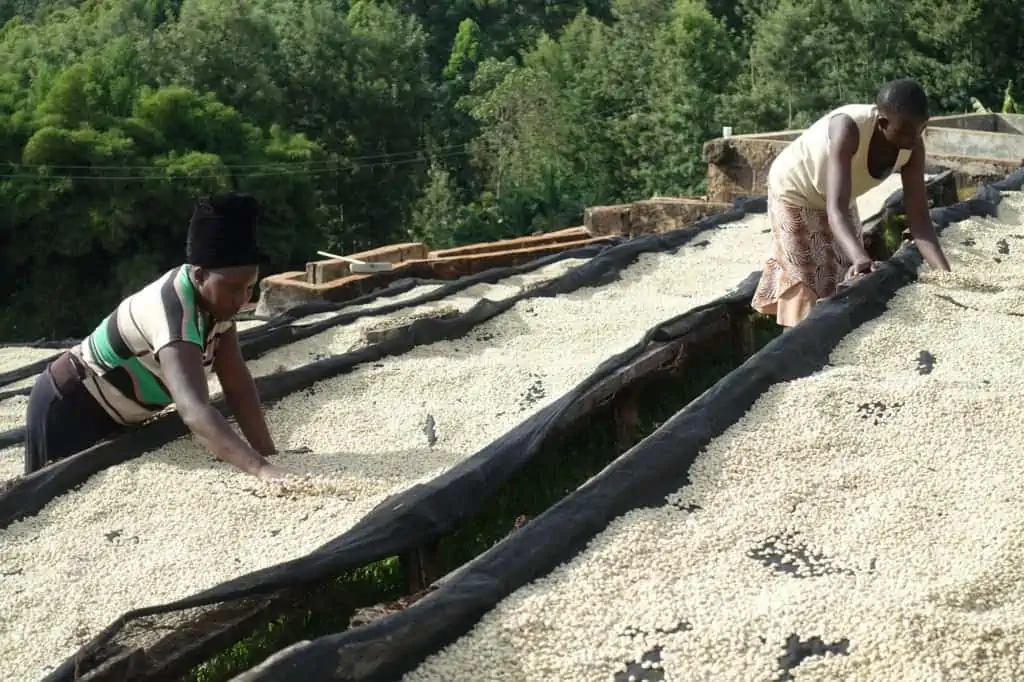
Turning drying coffee in Kiambu, Kenya. Photo courtesy of Kakalove Cafe.
And whether or not the presence of Ruiru 11 and Batian is contributing to a much-feared dumbing down of the Kenya cup is difficult to assess from this distance because almost all lots of Kenya that reach markets comprise a mix of varieties, sometimes only SL28 and SL34, but often some of the new hybrid varieties as well. If there is erosion of Kenya distinction due to this shifting mix of varieties it would be difficult to confirm based on the brilliance of some of this month’s 95- and 94-rated samples that include at least some Batian and Ruiru 11 in the variety mix reported by importers.
Kenya Terroir and Kenya Acidity
Most of the prime coffee-growing terrain in Kenya is at high elevations, from 1,400 meters to 2,000 meters (4,600 to 6,600 feet) above sea level. Night temperatures are cool and trees are stressed, encouraging slow bean development and potentially increasing bean density and, presumably, cup complexity.
The aspect of Kenya terroir that has attracted the most speculation is the mineral-rich volcanic loam on the high volcanic plateaus around Mt. Kenya and the foothills of the Aberdare Range where classic Kenyas are grown, and its possible relationship to Kenya coffees’ high-toned, often “sparkling,” acidity.
Acids that most contribute to cup character are all organic – produced by the plant itself – with the exception of phosphoric acid, which is inorganic and comes from the soil. Apparently, soils in the classic Kenya growing regions are rich in phosphoric acid. Phosphoric acid is added to sodas to brighten flavor and make them more tangy, leading to the assumption that phosphoric-rich soils contribute to the vibrancy of acidity in the best Kenyas.
In fact, the acidy sensation of Kenyas is complex and varied: sometimes bright and light-footed, sometimes citrusy, sometimes winey (or tannic). What sets Kenya apart from most specialty producing origins is not just the quality of its coffees’ acidity but its clarity. In the best examples, including all 11 of the coffees we review here, the various experiences of acidity are all expressive and clear.
It’s difficult to drill down to the influence of soil type in specific coffee-growing regions as compared with others, as less effort has been put into identifying regional distinctions in soil (and terroir, more generally) in the coffee industry than in the world of wine, where terroir is a chief marketing distinction about which much research is conducted, down to the sun’s angle on each vineyard slope.
Regional Distinctions
The three regions represented by the 11 coffees we review here, however, are well-known and fairly consistent in their cup presentation: Nyeri, Kiambu and Kirinyaga, which form a triangle at the base of Mt. Kenya. Coffees grown in the Nyeri region tend to be bright, sweetly tart (sometimes tropical) and high-toned, while Kirinyagas are often more floral-driven and sometimes sweetly savory. Kiambu County coffees run the gamut from round and cocoa-toned to berry-driven and citrusy, depending on varieties selected.
Kenya’s Meticulous Grading and Processing Methods
While the cherries’ ripeness at picking is perhaps the most important determinant of cup quality, Kenya’s green processing and grading is consistently painstaking.
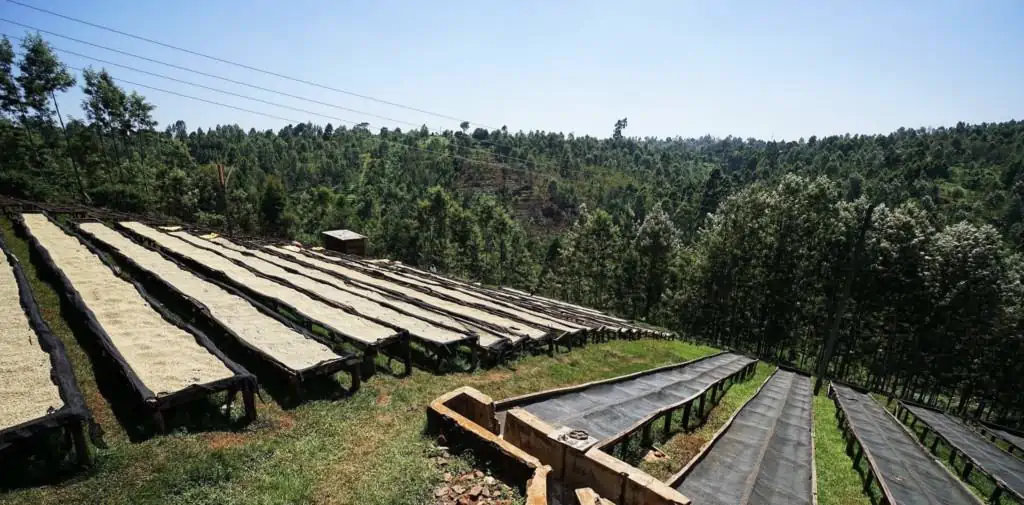
Drying coffee on raised beds in the Kiambu growing region of Kenya. Photo courtesy of Pebble Coffee.
Kenya is particularly famous for its meticulous washing process, which involves pulping (skin removal), then fermenting the beans for 12 to 24 hours before rinsing and soaking them again overnight in fresh water. The so-called “Kenya process” or double-soak is often cited as a contribution to the unique character of Kenya coffee, although the details of its impact have not been systematically studied.
After the green coffee has been dried and rested, it is hulled and subjected to mechanical and electronic grading, which removes imperfect or defective beans and separates beans by size. In the Kenya system, only large screen 18 beans are classified as AA, while screen 16s are labeled as AB. These size distinctions are not directly correlated with quality but rather with consistency. Some roasters may prefer AB, just as some lovers of maple syrup prefer grade B to grade A. It is a matter of specific coffee lot and personal preference.
Kenya’s Auction System
Instituted in 1934 and still held at the Nairobi Coffee Exchange, the government-run Kenya coffee auction is often cited as another reason Kenya coffees excel in quality and distinction. Auction systems exist, or have existed, in other East African coffee countries, but the Kenya system is the most influential and admired. Cooperatives submit lots of coffee to the Nairobi Coffee Exchange, and samples of these lots are made available to licensed dealers who will, 12 days later, have an opportunity to bid on them on either their own behalf or on behalf of their customers, typically roasters or importers.
The logic of this auction system, which ties price discovery to cup quality and character, has been much praised in the coffee world, but in recent times the auction has come under fire both by cooperatives and specialty green-coffee buyers. The cooperatives claim its complications add too much cost to the coffee, money that never makes it back to them, while specialty coffee buyers would rather buy directly from cooperatives for reasons of traceability and partnership.
Consequently, in 2006, the Kenyan government relaxed the rules that required all coffees to be sold through auction and began licensing independent marketing agents who can bypass the auction and trade on the open market. This step also has created controversy, however, and the Kenya trading system as a whole continues in a process of re-examination.
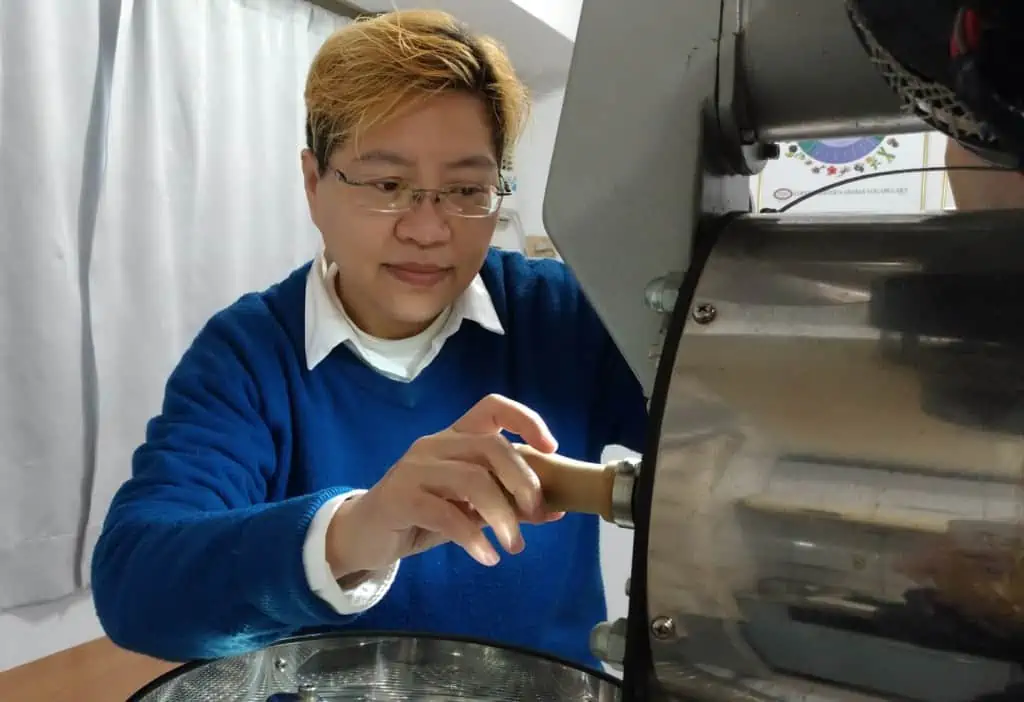
Riches Liao of DoDo Kaffa in Taipei. Photo courtesy of DoDo Kaffa.
The 11 Kenyas Reviewed
These are some of the most delicious coffees we’ve tasted all year, all rated at 94 or 95 Five come from roasters in Taiwan, five from roasters in the U.S., and one from a roaster in Toronto, Canada. While there is much nuance and range — from fruit-toned and juicy to deep and chocolaty, to savory and complex — each offers an element of the “classic” Kenya cup profile so many of us love.










